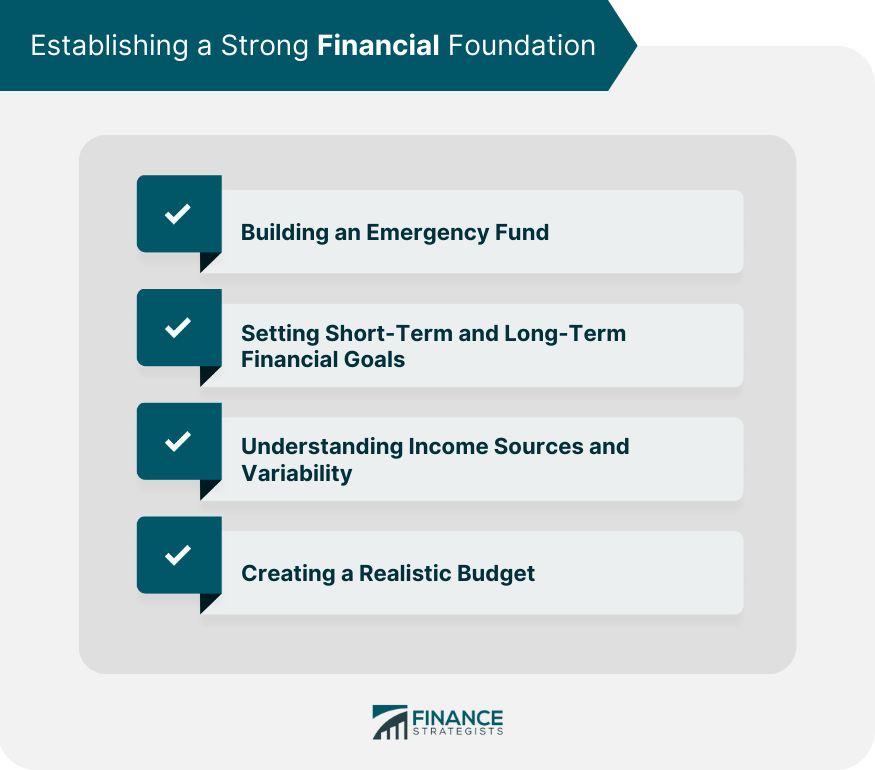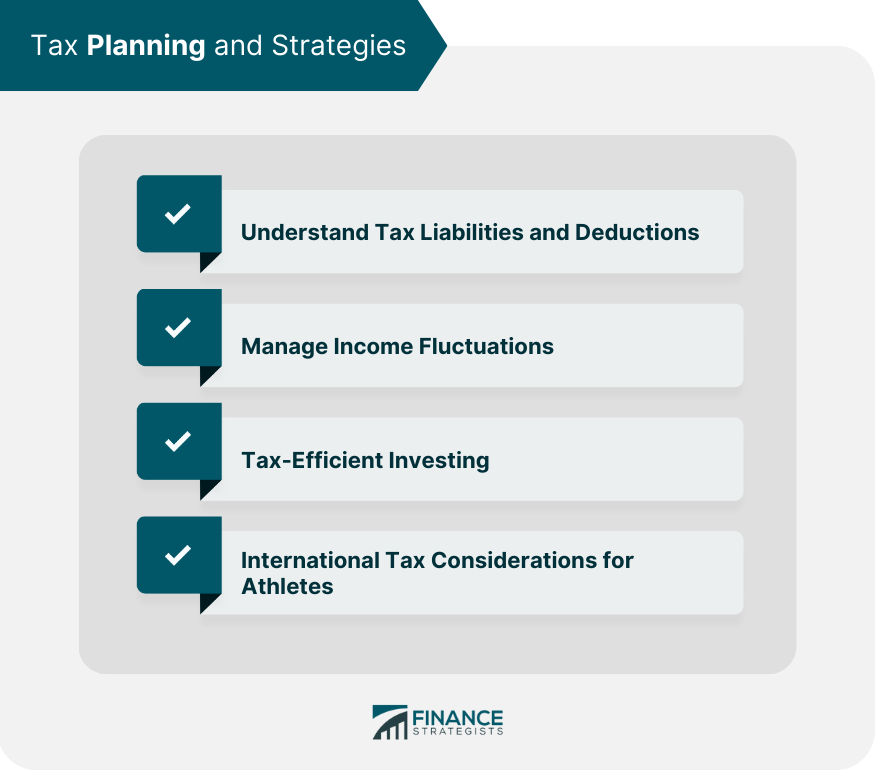Financial planning is essential for everyone, but it is particularly crucial for professional athletes who often have unique financial challenges. Financial planning is important to professional athletes because it helps them manage their wealth, prepare for the future, and navigate the unique financial challenges that come with their careers, such as fluctuating income, taxes, and investments. An emergency fund is a vital component of any financial plan, providing a safety net in case of unexpected expenses, injuries, or other financial setbacks. Professional athletes should aim to accumulate three to six months' worth of living expenses in a liquid, easily accessible account. Setting specific and measurable financial goals can help athletes make informed decisions and maintain focus on their financial objectives. Examples of short-term goals may include paying off high-interest debt or saving for a down payment on a home, while long-term goals could involve funding a child's education or achieving financial independence. Professional athletes often experience irregular income streams due to factors such as contract negotiations, endorsements, and performance bonuses. It is essential to understand the various sources of income and their variability to create a realistic budget and financial plan. A budget is a fundamental tool that helps athletes manage their finances by tracking income and expenses. By establishing a budget, athletes can better understand their spending habits, identify areas for improvement, and ensure they are on track to achieve their financial goals. One of the key aspects of managing finances is distinguishing between necessary expenses and discretionary spending. By prioritizing needs over wants, athletes can make more informed decisions and avoid overspending on non-essential items. Athletes can improve their financial health by identifying and implementing cost-saving measures in their daily lives. Examples include cooking at home, purchasing items on sale, and seeking out discounts or negotiating fees for services. Regularly reviewing income and expenses is essential for maintaining a healthy financial position. By monitoring cash flow, athletes can quickly identify any financial issues and make adjustments as needed. Managing debt and maintaining a good credit score are critical components of financial planning. Athletes should aim to minimize high-interest debt, pay bills on time, and use credit wisely to maintain a strong credit profile. Athletes should consider various savings vehicles, such as high-yield savings accounts, money market accounts, and certificates of deposit, to maximize their savings potential. A well-diversified investment portfolio can help reduce risk and enhance potential returns. Athletes should work with a financial advisor to develop an investment strategy that aligns with their risk tolerance and financial goals. Each athlete's risk tolerance and investment time horizon will vary based on their unique financial situation and goals. It is important to understand these factors when selecting investments and creating a comprehensive financial plan. A financial advisor can provide valuable guidance and support in managing an athlete's investments, helping to navigate the complexities of the financial world and ensuring their portfolio aligns with their objectives. Professional athletes should familiarize themselves with the tax implications of their income sources and identify potential deductions to minimize their tax liability. Given the variable nature of athletes' income, it is crucial to develop strategies to manage income fluctuations. These strategies may include setting aside funds during high-income periods to cover expenses during lower-income periods and adjusting spending habits accordingly. Tax-efficient investing can help athletes maximize their after-tax returns. By working with a financial advisor, athletes can identify tax-advantaged investment options, such as retirement accounts and municipal bonds, that align with their financial goals. Athletes competing or earning income in multiple countries may face complex international tax considerations. Consulting with tax professionals who specialize in international tax law can help navigate these complexities and ensure compliance with tax regulations. Insurance plays a critical role in protecting an athlete's financial well-being. Athletes should evaluate their insurance needs, including health, disability, life, and property insurance, to ensure adequate coverage. Disability insurance can help safeguard an athlete's income in the event of a career-ending injury or illness. Athletes should consider obtaining a policy that provides adequate coverage and aligns with their unique needs. Life insurance can provide financial protection for an athlete's dependents in the event of their death. Athletes should work with an insurance professional to determine the appropriate type and amount of coverage. Liability and property insurance can help protect athletes from potential lawsuits and property damage. Athletes should evaluate their unique risks and obtain the necessary coverage to minimize potential financial losses. Athletes should estimate their retirement needs, taking into account factors such as projected living expenses, healthcare costs, and desired lifestyle, to determine the amount of savings required for a comfortable retirement. Utilizing tax-advantaged retirement savings vehicles, such as 401(k)s, IRAs, and Roth IRAs, can help athletes maximize their retirement savings and reduce their tax liability. A retirement income plan can help athletes ensure they have sufficient income to cover expenses throughout their retirement. Working with a financial advisor, athletes can develop a strategy that includes a mix of guaranteed income sources, such as pensions or annuities, and investments. Professional athletes often retire at a relatively young age, which may necessitate a post-career transition. Athletes should consider their interests and skills and develop a plan to pursue new career opportunities or business ventures after their athletic career ends. Wills and trusts are essential components of an estate plan, ensuring the appropriate distribution of assets and minimizing potential disputes among heirs. Athletes should work with an estate planning attorney to establish these documents and review them regularly. Wealth transfer planning can help athletes minimize estate taxes and ensure their assets are distributed according to their wishes. Strategies may include establishing trusts, gifting assets, or using life insurance policies for estate liquidity. Many athletes choose to engage in charitable giving and philanthropy as part of their estate plan. Working with a financial advisor, athletes can develop a giving strategy that aligns with their values and maximizes the impact of their contributions. Collaborating with a team of professional advisors, including financial planners, attorneys, and tax professionals, can help athletes create a comprehensive and cohesive estate plan. A financial advisor can provide invaluable guidance and support in managing an athlete's finances. Athletes should carefully evaluate potential advisors, considering factors such as credentials, experience, and compatibility, to ensure they select a trusted professional who can meet their unique needs. Collaborating with tax and legal professionals can help athletes navigate complex financial and legal matters, ensuring compliance with regulations and minimizing potential liabilities. Athletes should maintain open communication with their agents and managers, ensuring all parties are aligned with the athlete's financial goals and objectives. This collaboration can help maximize earning potential and create a supportive environment for financial success. Regular communication and education are essential components of a successful financial planning relationship. Athletes should stay informed about their financial situation, ask questions, and actively participate in the planning process to ensure their financial plan remains aligned with their evolving needs and goals. Financial planning is vital for professional athletes to manage their wealth, prepare for the future, and navigate the unique financial challenges that come with their careers. From building an emergency fund to retirement planning, managing income and expenses, tax planning, insurance and risk management, estate planning and wealth transfer, and building a professional support team, athletes should carefully consider each aspect of their finances. Ongoing communication and education are also essential for ensuring that the financial plan remains aligned with their evolving needs and goals. By establishing a strong financial foundation and adhering to sound financial practices, athletes can safeguard their financial well-being and achieve long-term financial success.Importance of Financial Planning for Professional Athletes
Establishing a Strong Financial Foundation

Building an Emergency Fund
Setting Short-Term and Long-Term Financial Goals
Understanding Income Sources and Variability
Creating a Realistic Budget
Managing Income and Expenses
Differentiating Between Needs and Wants
Implementing Cost-Saving Measures
Monitoring Cash Flow
Minimizing Debt and Managing Credit
Saving and Investing
Identifying Appropriate Saving Vehicles
Diversifying Investments
Understanding Risk Tolerance and Time Horizon
Working With a Financial Advisor
Tax Planning and Strategies

Understanding Tax Liabilities and Deductions
Managing Income Fluctuations
Tax-Efficient Investing
International Tax Considerations for Athletes
Insurance and Risk Management
Evaluating Insurance Needs
Protecting Income With Disability Insurance
Securing Life Insurance
Considering Liability and Property Insurance
Retirement Planning
Estimating Retirement Needs
Maximizing Retirement Savings Vehicles
Developing a Retirement Income Plan
Preparing for Post-career Transitions
Estate Planning and Wealth Transfer
Establishing Wills and Trusts
Planning for Wealth Transfer to Heirs
Charitable Giving and Philanthropy
Coordinating Estate Planning With Professional Advisors
Building a Professional Support Team
Selecting a Financial Advisor
Working With Tax and Legal Professionals
Collaborating With Agents and Managers
Importance of Ongoing Communication and Education
Final Thoughts
Professional Athlete Financial Planning FAQs
Professional athlete financial planning is crucial because athletes often have unique financial challenges, such as irregular income streams and a relatively short career span. Financial planning helps athletes build a strong financial foundation, manage income and expenses, save and invest wisely, plan for retirement, and protect their wealth for long-term stability and security.
Professional athlete financial planning helps athletes manage income fluctuations by creating a realistic budget, setting aside funds during high-income periods, and adjusting spending habits as needed. This approach allows athletes to maintain financial stability despite variable income streams.
Insurance is a key component of professional athletes financial planning, as it helps protect an athlete's financial well-being from unforeseen events. Athletes should evaluate their insurance needs, including health, disability, life, and property insurance, to ensure they have adequate coverage in case of injury, illness, or other financial setbacks.
Professional athlete financial planning addresses retirement needs by helping athletes estimate the savings required for a comfortable retirement, maximize retirement savings vehicles and develop a retirement income plan. This ensures athletes have sufficient income to cover expenses throughout their retirement, despite often retiring at a relatively young age.
A team of trusted professionals should be involved in professional athlete financial planning, including financial advisors, tax and legal professionals, agents, and managers. This collaborative approach ensures athletes receive expert guidance in managing their finances, navigating complex financial and legal matters, and achieving their financial goals.
True Tamplin is a published author, public speaker, CEO of UpDigital, and founder of Finance Strategists.
True is a Certified Educator in Personal Finance (CEPF®), author of The Handy Financial Ratios Guide, a member of the Society for Advancing Business Editing and Writing, contributes to his financial education site, Finance Strategists, and has spoken to various financial communities such as the CFA Institute, as well as university students like his Alma mater, Biola University, where he received a bachelor of science in business and data analytics.
To learn more about True, visit his personal website or view his author profiles on Amazon, Nasdaq and Forbes.











